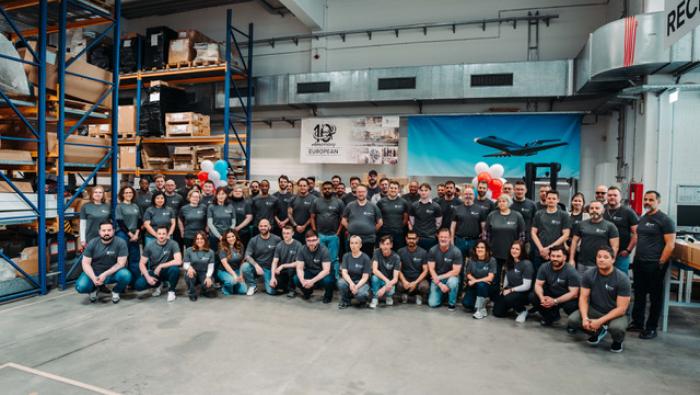It was a long flight and a relatively slow flight, but the trip in a modified King Air 350 from Orlando to Albuquerque likely broke a city-pair record (official acknowledgment is pending), thanks to the active winglets installed by Tamarack Aerospace.
On the way to the static display at Orlando Executive Airport for last October’s NBAA-BACE event, Tamarack made the trip nonstop, from Spokane International Airport in Washington to Orlando. Piloted by Jesse Nonnemacher, the Performance SmartWing-equipped King Air 350 flew 2,032.8 nm in 7 hours 46 minutes, averaging 240 ktas. Tailwinds averaging 20 knots helped propel the King Air and allowed for lower power settings to extend range. In addition to the Orlando-Albuquerque flight, Tamarack has also submitted the Spokane-Orlando city pair trip to the National Aeronautic Association and European Federation Aeronautique International for record recognition.
Tamarack founder and CEO Nick Guida had planned to break a new city pair record on the way back from BACE, but this time from Orlando to Las Vegas. The King Air needed to fly to Henderson, Nevada, for some scheduled maintenance, and it was a good opportunity to try for another record.
On the last day of BACE, however, the winds at the King Air’s most efficient altitude (FL340/350) were extremely uncooperative. I joined the flight for the return trip, which was captained by Lorin Meyers, in part because I planned some time off in Las Vegas after BACE but also to experience first-hand what it was like to fly a city-pair record flight.
Any aircraft can be flown in a city-pair record attempt, and there are various classes of aircraft that make the playing field fairly level. What made this King Air 350 unique and able to go for longer records, however, was the Tamarack SmartWing active winglets. Adding winglets to any airplane increases the aspect ratio of the wing, which improves performance not only by reducing drag from wingtip vortices but also by allowing a climb to a higher initial and thus more efficient altitude. But the longer wingspan and winglets add aerodynamic loads to the wing, so the structure has to be strengthened, which adds weight and subtracts some of the efficiency improvement. What makes Tamarack’s winglets different is the addition of its active technology load alleviation system (Atlas) active-camber surfaces (TACS) near the ends of the wings. The TACS actuate only to counteract an extra load when it happens, such as during turns or when encountering turbulence and gusts, and the rest of the time they sit passively, waiting for the next load to come along. The Atlas system thus requires less structural enhancement, and in the CitationJet series produces efficiency improvements of up to 30 percent, allowing faster climbs to higher altitudes and longer range. For the King Air 350, the SmartWing mod adds six feet of wingspan and dual TACS, which allows continuation of flight at normal speed with one TACS failed. In single-TACS installations, as on the CitationJets, pilots must reduce airspeed if a TACS fails because the aerodynamic loads are no longer being alleviated.
After waiting for the BACE static display to clear out enough so we could depart on October 20, Guida and Meyers filed a hopeful nonstop flight plan to Henderson. We already knew that it was unlikely we’d make it that far with the required minimum fuel reserves, but perhaps the weather gods would relent once we got going. Sadly, it wasn’t to be.
We departed from Orlando Executive as the sun was setting, with a full load of 3,610 pounds of fuel onboard and weighing 13,000 pounds, 1,000 pounds under the airplane’s 14,000-pound mtow. The climb to FL350 took 32 minutes, and our flight plan took us from Florida over Alabama, Mississippi, Arkansas, Oklahoma, and Texas. The Garmin G1000 avionics gave Meyers and Guida plenty of real-time information on the progress of our flight, which we were all tracking on ForeFlight as well (I was using ForeFlight’s Sentry Plus ADS-B receiver to monitor the weather and our progress).

Almost immediately, it became obvious that the strong winds aloft weren’t going to allow the 1,804-nm nonstop flight to Henderson. The outside air temperature at altitude was slightly warmer than normal but not enough to affect performance much. After leveling off, fuel consumption stabilized at 250 pph for each of the Pratt & Whitney Canada PT6 engines, and later during the flight this dropped to 210 pph.
Our groundspeed showed how much the wind was holding us back. Early in the flight, we dipped down to 198 knots. As the King Air droned on and on into the night, the wind occasionally let up and our groundspeed peaked at 267 knots, but not for long enough to allow us to fly much further than Albuquerque. Just before we began descending for our unplanned fuel stop at Albuquerque, groundspeed had dropped to just 190 knots.

We landed at Albuquerque with 500 pounds of fuel, a decent reserve for the clear weather, having flown 6 hours 24 minutes and 1,400 nm. The fine line crew at Cutter Aviation quickly refueled the King Air, and we were soon back in the air for the 1-hour, 44-minute flight to Henderson, this time at FL250. It was well after midnight when we landed, and the FBO was closed, so we exited the ramp through the keycode gate.
Although it had been an extra-long trip, the Tamarack-modified King Air lived up to its performance promises and showed that the SmartWing modification extends the range of the twin turboprop. A stock King Air 350 wouldn’t have been able to make it to Albuquerque in those conditions.







